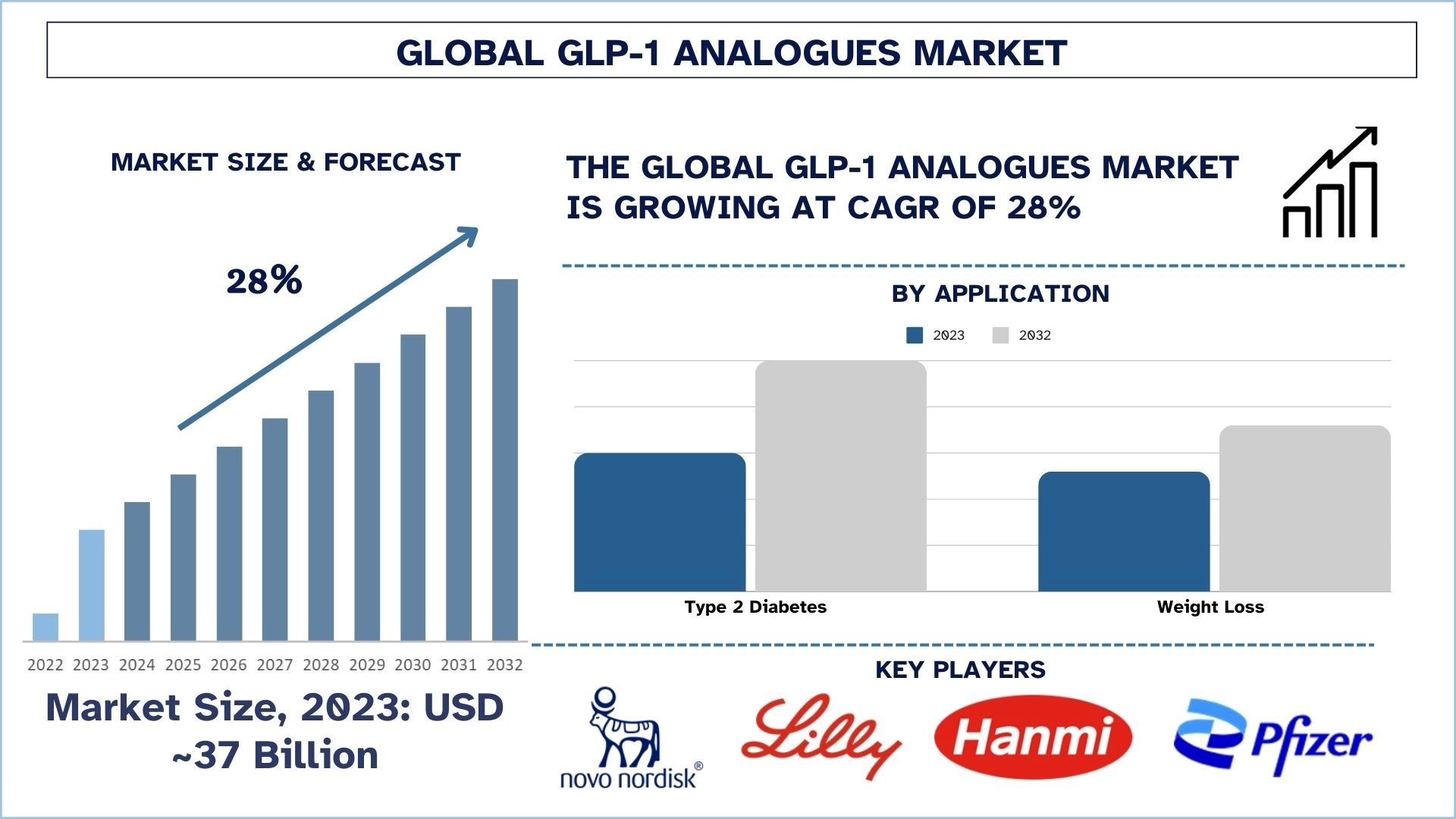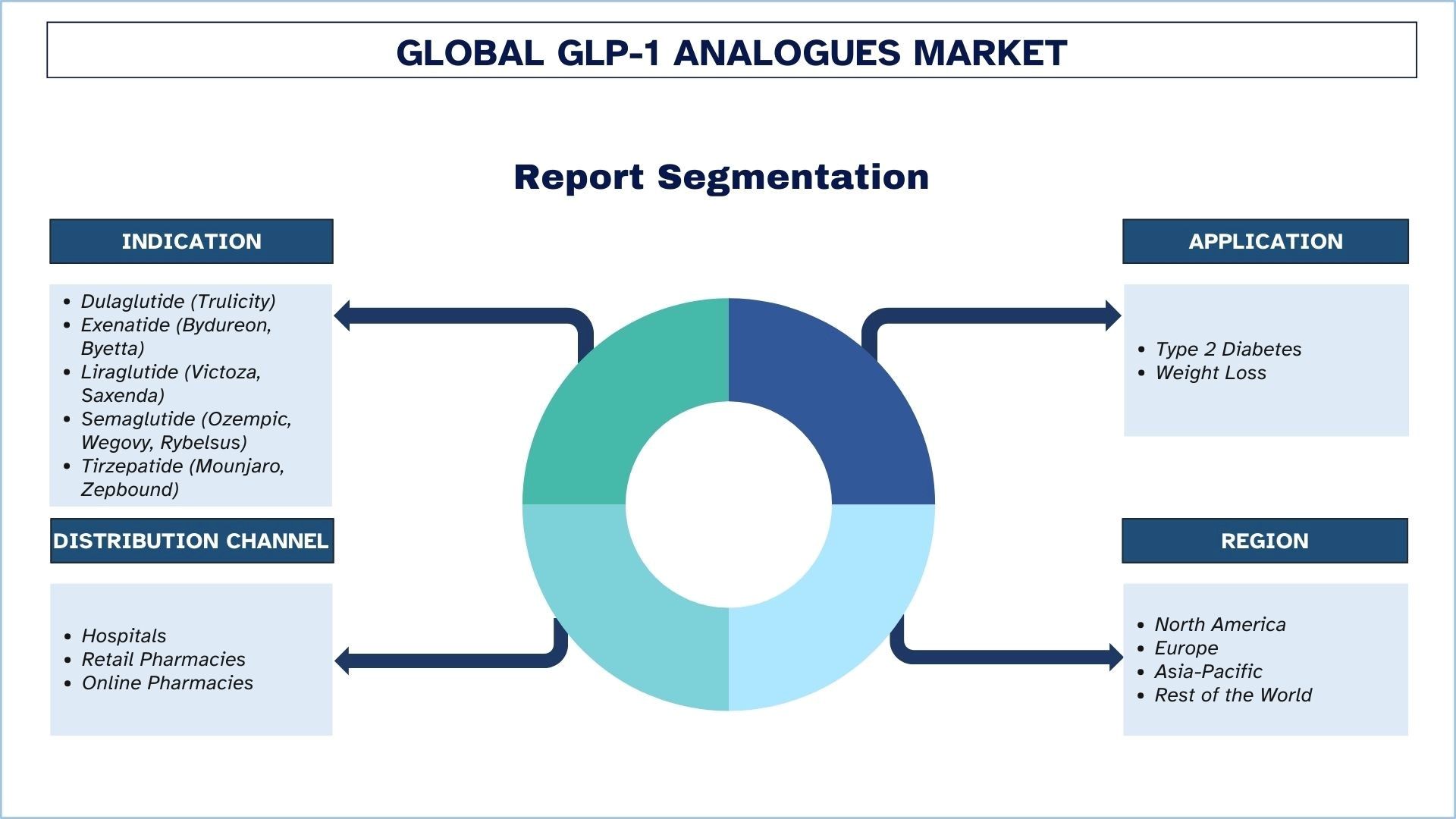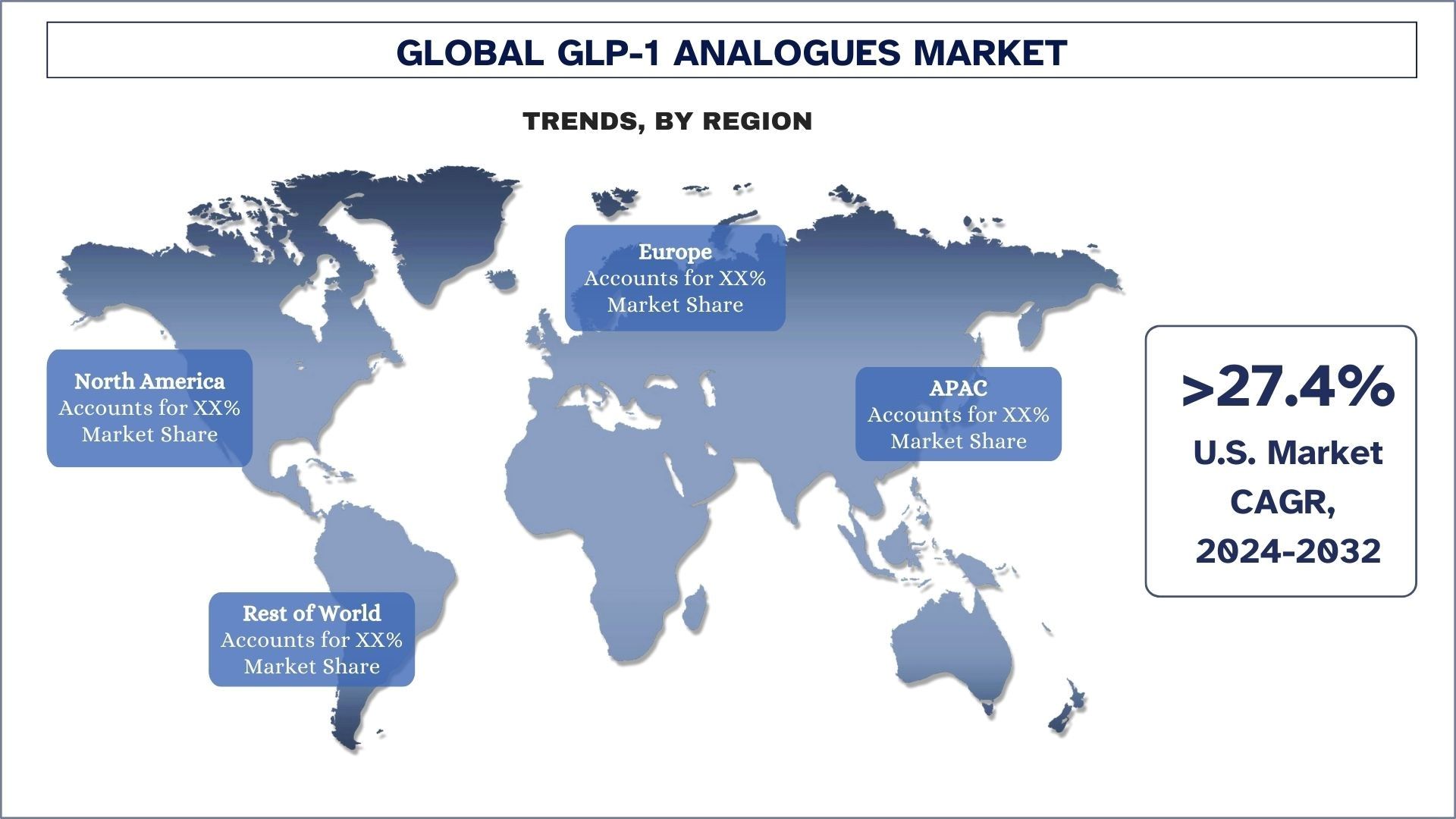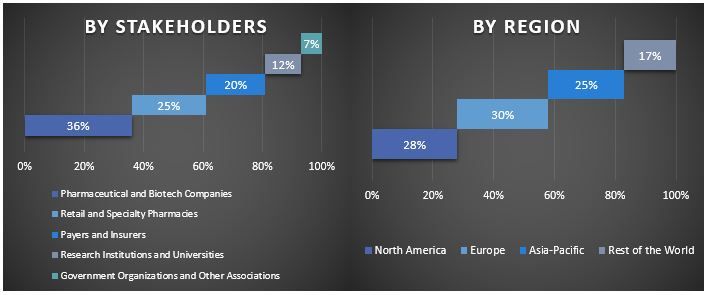GLP-1受容体作動薬市場:現状分析と予測 (2024年~2032年)
適応症の重視[デュラグルチド(トルリシティ)、エキセナチド(ビデュリオン、バイエッタ)、リラグルチド(ビクトーザ、サクセンダ)、セマグルチド(オゼンピック、ウゴービ、リベルサス)、チルゼパチド(マンジャロ、ゼップバウンド)];用途(2型糖尿病、体重減少);流通チャネル(病院、小売薬局、オンライン薬局);および地域/国

GLP-1アナログ市場規模と予測
GLP-1アナログ市場は2023年に約370億米ドルと評価され、2型糖尿病と肥満の有病率の上昇により、予測期間(2024年~2032年)中に約28%の著しいCAGRで成長すると予想されています。
GLP-1アナログ市場分析
GLP-1アナログは、天然ホルモンであるGLP-1と同様の作用を発揮するペプチドをベースとした合成製品です。これらは、食物摂取に対するインスリン反応を効果的に刺激し、グルカゴンの放出を抑制し、胃の排出を遅らせ、満腹感を引き起こすため、2型糖尿病および肥満の治療によく使用されます。リラグルチド、セマグルチド、デュラグルチドなどの新世代GLP-1アナログは、心血管系のプラスを示し、体重管理介入に役立つことが証明されています。現在、これらは注射剤として存在し、コンプライアンスと利便性を高めるために経口剤の形で徐々に発売されています。
GLP-1アナログの市場を拡大するために、継続的に出現している主な戦略は、製剤の革新、長時間作用型GLP-1アナログの研究開発、強化された経口送達システム、およびインスリンなどの他の製品とGLP-1アナログを使用した固定用量併用療法です。さらに、協力合意、ライセンスおよび販売合意、そして新しい経済圏における有望な市場への参入がアクセスを向上させています。また、デジタルヘルス製品を通じて、患者の焦点の変化とともに、治療プログラムの消費者への直接的なプロモーションと厳格な患者コンプライアンスが見られます。
例えば、2024年7月11日、ファイザー社(NYSE: PFE)は、現在進行中の薬物動態試験(NCT06153758)の結果に基づいて、経口グルカゴン様ペプチド-1(GLP-1)受容体作動薬であるダヌグリプロンの、1日1回投与の徐放性製剤を選択したと発表しました。ファイザー社は、登録を可能にする試験を知らせるために、優先される徐放性製剤の複数の用量を評価する用量最適化試験を2024年後半に実施する予定です。
GLP-1アナログ市場動向
このセクションでは、当社の調査専門家が特定した、GLP-1アナログ市場のさまざまなセグメントに影響を与える主要な市場動向について説明します。
リラグルチド(ビクトーザ、サクセンダ)がGLP-1アナログ業界を変革する
リラグルチド(ビクトーザ、サクセンダ)は、2023年に市場の大きなシェアを占めました。リラグルチドは、2型糖尿病と肥満の両方の治療に有効な、心血管効果のある多様なGLP-1であるため、この分野の主要な成長ドライバーです。糖尿病にはビクトーザ、肥満にはサクセンダというブランド名で販売されている製品の汎用性は、より広い市場基盤を意味します。さらに、企業は適応症の拡大、マーケティングイニシアチブの強化、および送達システムによるコンプライアンスの向上へのアプローチに集中しています。例えば、2024年6月24日、テバファーマシューティカルインダストリーズ社(NYSEおよびTASE: TEVA)の米国関連会社であるテバファーマシューティカルズ社は、米国でビクトーザ®1(リラグルチド注射剤1.8mg)の正規ジェネリックの発売を発表しました。

北米が市場をリードしています。
北米は、2型糖尿病と肥満の症例が最も多く、高度に発達した医療システムを持ち、革新的な治療法への浸透が高く、GLP-1アナログの成長を推進しています。これに加えて、市場の発展には、適切な償還に対する姿勢と、患者の意識向上が含まれます。企業は研究開発に多額の投資を行い、新製品を市場に投入し、医療機関と契約を結び、顧客基盤を拡大しています。可視性は、米国とカナダにおける医薬品および製品プロモーションの規制当局の承認が奨励される理由です。
例えば、2024年12月2日、米国糖尿病学会(ADA)は、配合GLP-1 RA(グルカゴン様ペプチド-1受容体作動薬)および二重GIP/GLP-1 RA(グルコース依存性インスリン分泌刺激ポリペプチドおよびGLP-1 RA)薬物クラスの使用に関するガイダンスステートメントを発表しました。この声明では、内容、安全性、品質、および有効性に関する不確実性のため、食品医薬品局(FDA)が承認していない配合GLP-1および二重GIP/GLP-1 RA製品を使用しないことを推奨しています。

GLP-1アナログ業界の概要
GLP-1アナログ市場は競争が激しく、多くのグローバルおよび国際的なプレーヤーが存在します。主要なプレーヤーは、パートナーシップ、合意、コラボレーション、新製品の発売、地理的拡大、合併および買収など、市場での存在感を高めるためにさまざまな成長戦略を採用しています。市場で活動している主要なプレーヤーには、ノボノルディスクA/S、イーライリリー、サノフィ、アストラゼネカ、ファイザー社、ベーリンガーインゲルハイムインターナショナルGmbH、アムジェン社、ジーランドファーマ、メルク・アンド・カンパニー社、ハンミ薬品などがあります。
GLP-1アナログ市場ニュース
2023年6月12日、米国およびカナダ以外ではMSDとして知られるメルク(NYSE: MRK)は、治験薬であるGLP-1/グルカゴン受容体共作動薬であるエフィノペグデュチド(MK-6024)の新しい知見が、6月21〜24日に開催される欧州肝臓学会(EASL)年次総会での口頭発表に採択されたと発表しました。
2022年5月13日、米国食品医薬品局(FDA)は、イーライリリー・アンド・カンパニー(NYSE: LLY)の新しい週1回投与のGIP(グルコース依存性インスリン分泌刺激ポリペプチド)およびGLP-1(グルカゴン様ペプチド-1)受容体作動薬であるMounjaro™(チルゼパチド)注射剤を承認しました。Mounjaroは、食事療法と運動の補助として、2型糖尿病の成人における血糖コントロールを改善することが示されています。Mounjaroは、膵炎の病歴のある患者では研究されておらず、1型糖尿病の患者での使用は適応されていません。
GLP-1アナログ市場レポートの範囲
レポート属性 | 詳細 |
基準年 | 2023年 |
予測期間 | 2024年~2032年 |
成長の勢い | CAGR 28%で加速 |
2023年の市場規模 | 370億米ドル |
地域分析 | 北米、ヨーロッパ、アジア太平洋、その他の地域 |
主要な貢献地域 | アジア太平洋は、予測期間中に最高のCAGRで成長すると予想されています。 |
対象となる主要国 | 米国、カナダ、ドイツ、フランス、英国、スペイン、イタリア、中国、日本、インド |
プロファイルされた企業 | ノボノルディスクA/S、イーライリリー、サノフィ、アストラゼネカ、ファイザー社、ベーリンガーインゲルハイムインターナショナルGmbH、アムジェン社、ジーランドファーマ、メルク・アンド・カンパニー社、ハンミ薬品 |
レポート範囲 | 市場動向、推進要因、および抑制要因。収益の見積もりと予測。セグメンテーション分析。需要と供給側の分析。競争環境。会社概要 |
対象セグメント | 適応症別、アプリケーション別、流通チャネル別、地域/国別 |
このレポートを購入する理由:
この調査には、認証された主要な業界専門家によって検証された市場規模と予測分析が含まれています。
このレポートは、業界全体のパフォーマンスの簡単な概要を一目で提供します。
このレポートは、主要なビジネス財務、製品ポートフォリオ、拡張戦略、および最近の開発に主な焦点を当てて、著名な業界ピアの詳細な分析を網羅しています。
業界で普及している推進要因、抑制要因、主要な傾向、および機会の詳細な調査。
この調査では、さまざまなセグメントにわたる市場を包括的に網羅しています。
業界の地域レベルの分析を深く掘り下げます。
カスタマイズオプション:
グローバルGLP-1アナログ市場は、要件またはその他の市場セグメントに応じてさらにカスタマイズできます。これに加えて、UMIは、お客様が独自のビジネスニーズをお持ちであることを理解しているため、お客様の要件に完全に適合するレポートを入手するには、お気軽にご連絡ください。
目次
GLP-1アナログ市場分析(2022年~2032年)の調査方法
世界のGLP-1アナログ市場の過去の市場分析、現在の市場規模の推定、将来の市場予測は、世界の主要地域におけるGLP-1アナログの普及状況を作成・分析するために行われた3つの主要なステップです。過去の市場数値を収集し、現在の市場規模を推定するために、徹底的な二次調査を実施しました。次に、これらの洞察を検証するために、数多くの調査結果と仮定を考慮しました。さらに、世界のGLP-1アナログ市場のバリューチェーン全体にわたる業界の専門家との徹底的な一次インタビューも実施しました。一次インタビューを通じて市場数の仮定と検証を行った後、トップダウン/ボトムアップアプローチを採用して、市場全体の規模を予測しました。その後、市場の内訳とデータ三角測量法を採用して、業界のセグメントとサブセグメントの市場規模を推定および分析しました。詳細な方法論を以下に説明します。
過去の市場規模の分析
ステップ1:二次資料の詳細な調査:
年次報告書と財務諸表、業績プレゼンテーション、プレスリリースなどの企業内部情報源や、ジャーナル、ニュース&記事、政府刊行物、競合他社の刊行物、セクターレポート、サードパーティデータベース、その他の信頼できる刊行物などの外部情報源を通じて、GLP-1アナログ市場の過去の市場規模を取得するために、詳細な二次調査を実施しました。
ステップ2:市場セグメンテーション:
GLP-1アナログ市場の過去の市場規模を取得した後、主要地域のさまざまなセグメントとサブセグメントの過去の市場の洞察とシェアを収集するために、詳細な二次分析を実施しました。主要なセグメントは、適応症、アプリケーション、流通チャネル、および地域としてレポートに含まれています。さらに、国レベルの分析を実施して、その地域でのテストモデルの全体的な普及状況を評価しました。
ステップ3:因子分析:
さまざまなセグメントとサブセグメントの過去の市場規模を取得した後、GLP-1アナログ市場の現在の市場規模を推定するために、詳細な因子分析を実施しました。さらに、GLP-1アナログ市場の適応症、アプリケーション、流通チャネル、および地域などの従属変数と独立変数を使用して因子分析を実施しました。世界のGLP-1アナログ市場セクターにおけるトップパートナーシップ、M&A、事業拡大、および製品発売を考慮して、需要側と供給側のシナリオについて徹底的な分析を実施しました。
現在の市場規模の推定と予測
現在の市場規模の算出:上記の3つのステップからの実用的な洞察に基づいて、現在の市場規模、世界のGLP-1アナログ市場の主要なプレーヤー、およびセグメントの市場シェアに到達しました。必要な割合シェアの分割と市場の内訳はすべて、上記の二次的アプローチを使用して決定され、一次インタビューを通じて検証されました。
推定と予測:市場の推定と予測のために、ステークホルダーが利用できる推進要因とトレンド、制約、および機会を含むさまざまな要因に重みが割り当てられました。これらの要因を分析した後、関連する予測手法、つまりトップダウン/ボトムアップアプローチを適用して、世界の主要市場全体のさまざまなセグメントとサブセグメントの2032年の市場予測に到達しました。市場規模の推定に採用された調査方法論は、次のことを網羅しています。
収益(米ドル)の観点からの業界の市場規模、および国内の主要市場全体でのGLP-1アナログ市場の採用率
市場セグメントとサブセグメントのすべての割合シェア、分割、および内訳
提供される製品の観点から見た世界のGLP-1アナログ市場の主要なプレーヤー。また、急速に成長している市場で競争するためにこれらのプレーヤーが採用した成長戦略
市場規模とシェアの検証
一次調査:主要地域全体で、トップレベルのエグゼクティブ(CXO/VP、営業責任者、マーケティング責任者、オペレーション責任者、地域責任者、カントリーヘッドなど)を含むKey Opinion Leaders(KOL)との詳細なインタビューを実施しました。次に、一次調査の結果を要約し、統計分析を実行して、述べられた仮説を証明しました。一次調査からのインプットは二次調査の結果と統合され、それによって情報が実用的な洞察に変わりました。
さまざまな地域における一次参加者の分割

市場エンジニアリング
データ三角測量法を採用して、市場全体の推定を完了し、世界のGLP-1アナログ市場の各セグメントとサブセグメントの正確な統計数値に到達しました。世界のGLP-1アナログ市場の適応症、アプリケーション、流通チャネル、および地域のさまざまなパラメーターと傾向を調査した後、データをいくつかのセグメントとサブセグメントに分割しました。
世界のGLP-1アナログ市場調査の主な目的
世界のGLP-1アナログ市場の現在および将来の市場動向は、調査で正確に特定されました。投資家は、調査で実施された定性的および定量的分析に基づいて、投資に関する裁量に基づいた戦略的な洞察を得ることができます。現在および将来の市場動向は、地域レベルでの市場全体の魅力を決定し、産業参加者が未開拓の市場を利用して先行者利益を享受するためのプラットフォームを提供します。調査のその他の定量的な目標は次のとおりです。
金額(米ドル)の観点から、GLP-1アナログ市場の現在および予測される市場規模を分析します。また、さまざまなセグメントとサブセグメントの現在および予測される市場規模を分析します。
調査のセグメントには、適応症、アプリケーション、流通チャネル、および地域の領域が含まれます。
GLP-1アナログの規制の枠組みを定義して分析します。
さまざまな仲介業者の存在を伴うバリューチェーンを分析するとともに、業界の顧客と競合他社の行動を分析します。
主要地域のGLP-1アナログ市場の現在および予測される市場規模を分析します。
レポートで調査された地域の主要な国には、アジア太平洋、ヨーロッパ、北米、およびその他の地域が含まれます。
GLP-1アナログ市場の企業プロファイル、および市場プレーヤーが急速に成長している市場を維持するために採用した成長戦略。
業界の詳細な地域レベルの分析
よくある質問 よくある質問
Q1: GLP-1受容体作動薬市場の現在の規模と成長の可能性は?
GLP-1受容体作動薬の市場規模は、2023年に370億米ドルと評価され、予測期間(2024年~2032年)中に年平均成長率(CAGR)28%で成長すると予想されています。
Q2: GLP-1アナログ市場の成長を牽引する要因は何ですか?
2型糖尿病および肥満の有病率の上昇、経口製剤や長時間作用型薬剤などのイノベーション、患者の意識向上、そして規制当局の承認が、GLP-1受容体作動薬市場を牽引しています。
Q3: 適応症別では、どのセグメントがGLP-1アナログ市場で最大のシェアを占めていますか?
リラグルチド(ビクトーザ、サクセンダ)は、GLP-1受容体作動薬市場において、適応症別で最大のシェアを占めています。
Q4:GLP-1受容体作動薬市場の主なトレンドは何ですか?
GLP-1受容体作動薬市場における主なトレンドは、経口製剤の台頭と、併用療法の開発です。
Q5: GLP-1受容体作動薬市場はどの地域が最も大きなシェアを占めますか?
北米が2023年の市場を支配しました。
関連 レポート
この商品を購入したお客様はこれも購入しました










